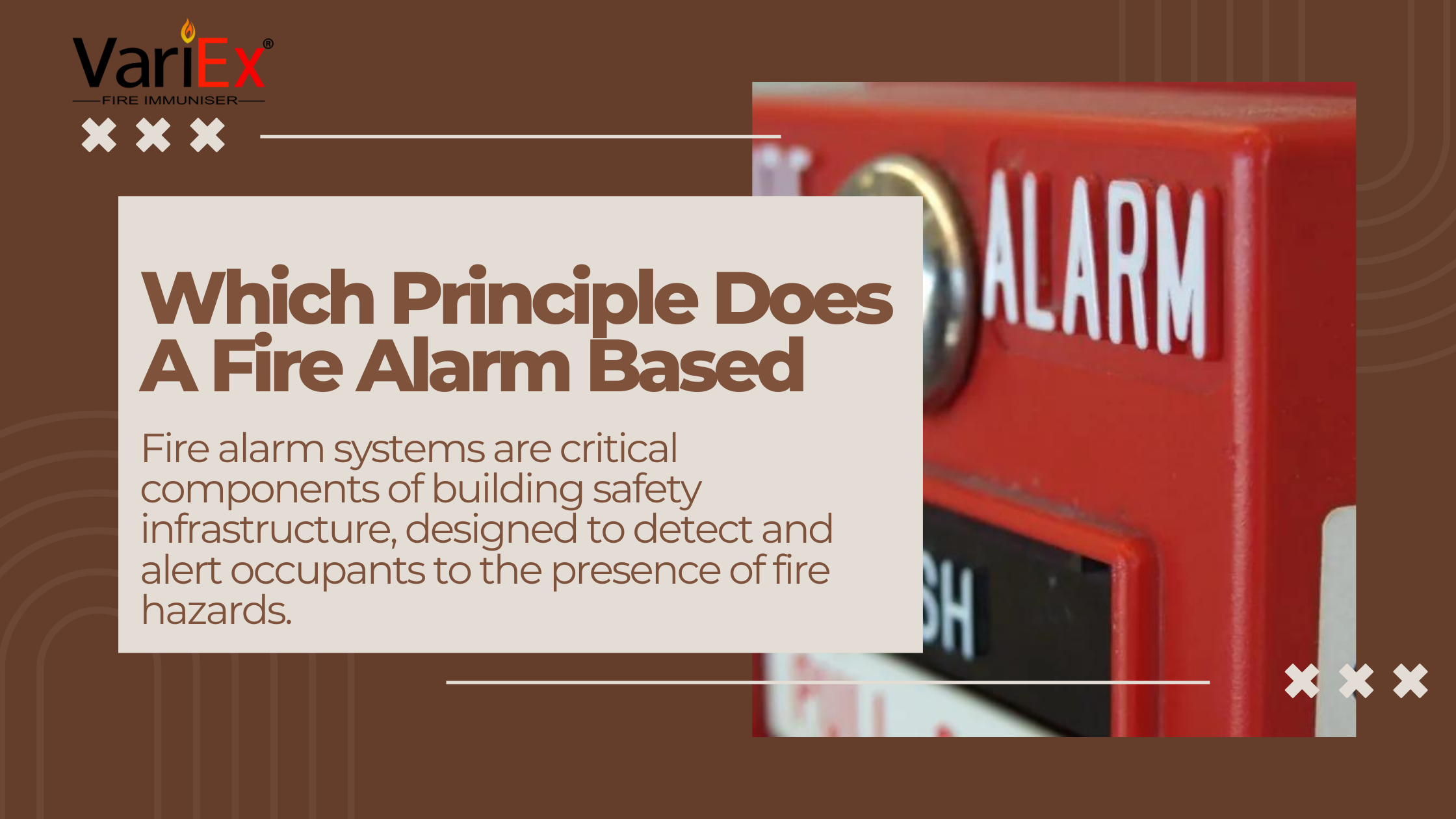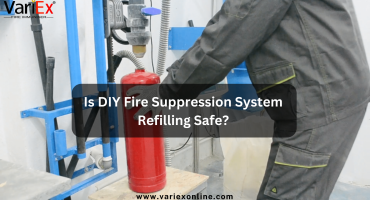![]()
Fire Immuniser
+91-7829629111
Email: info@variex.in
Varistor Technologies Pvt. Ltd.
Block-1, First Floor, Ardente Office One, Hoodi Circle, ITPL Main Road, Bengaluru, Karnataka 560048, IN
Which Principle Does A Fire Alarm Based
Which Principle Does A Fire Alarm Based
Fire alarm systems are critical components of building safety infrastructure, designed to detect and alert occupants to the presence of fire hazards. The principles on which fire alarm systems operate are rooted in various scientific and engineering concepts. This comprehensive guide delves into the principles underlying fire alarm systems, exploring how they detect fire, the technologies they use, and the standards that govern their design and operation.
The Fundamental Principles of Fire Alarm Systems
Fire alarm systems operate based on several fundamental principles, including the detection of smoke, heat, and flames, signal processing, and alarm activation. These principles ensure that fire hazards are detected early, allowing for timely evacuation and response.
1. Fire Detection Principles
The primary function of a fire alarm system is to detect fire. This is achieved through the following methods:
- Smoke Detection
- Heat Detection
- Flame Detection
- Gas Detection
Smoke Detection:
Smoke detectors are the most common type of fire detection device. They operate on two main principles:
- Ionization:
- Ionization smoke detectors use a small amount of radioactive material to ionize the air within a detection chamber. This creates a flow of ions between two electrodes. When smoke enters the chamber, it disrupts the ion flow, reducing the current and triggering the alarm.
- Ionization detectors are particularly sensitive to fast-flaming fires that produce smaller smoke particles.
- Photoelectric (Optical):
- Photoelectric smoke detectors use a light source and a photosensitive sensor. In the absence of smoke, the light beam does not reach the sensor. When smoke enters the chamber, it scatters the light, causing it to strike the sensor and trigger the alarm.
- Photoelectric detectors are more responsive to smoldering fires that produce larger smoke particles.
Heat Detection:
Heat detectors respond to changes in temperature caused by fire. There are two main types of heat detectors:
- Fixed Temperature:
- Fixed temperature heat detectors activate when the temperature exceeds a predetermined threshold, typically around 135°F (57°C). These detectors are reliable for detecting fires in environments where rapid temperature changes are common.
- Rate-of-Rise:
- Rate-of-rise heat detectors respond to a rapid increase in temperature, typically around 15°F (8.3°C) per minute. These detectors are effective in identifying fires that produce quick temperature spikes.
Flame Detection:
Flame detectors sense the presence of flames by detecting the unique spectral characteristics of fire. They can be categorized into three types based on the wavelengths they detect:
- Ultraviolet (UV):
- UV flame detectors sense the UV radiation emitted by flames. They are highly sensitive and can detect fires quickly but may be prone to false alarms from other UV sources.
- Infrared (IR):
- IR flame detectors detect the IR radiation emitted by flames. They are less prone to false alarms than UV detectors and are effective in detecting both visible and invisible flames.
- UV/IR:
- UV/IR flame detectors combine both UV and IR detection technologies, providing enhanced sensitivity and reduced false alarms by requiring both UV and IR signals to trigger an alarm.
Gas Detection:
Gas detectors identify the presence of combustible or toxic gases that may indicate a fire. These detectors operate on principles such as:
- Catalytic Combustion:
- Catalytic gas detectors use a catalytic element that oxidizes combustible gases, producing heat that changes the resistance of a sensing element, triggering the alarm.
- Infrared Absorption:
- Infrared gas detectors measure the absorption of IR light by gas molecules. The presence of specific gases changes the absorption spectrum, triggering the alarm.
2. Signal Processing Principles
Once a fire detection device identifies a fire-related phenomenon, the signal is processed to determine whether an alarm should be activated. Signal processing involves:
- Signal Conditioning:
- Signal conditioning filters and amplifies the raw signal from the detector to reduce noise and enhance the signal quality.
- Analog-to-Digital Conversion:
- The conditioned signal is converted from an analog form to a digital form for further processing by the fire alarm control panel.
- Algorithm-Based Analysis:
- Advanced fire alarm systems use algorithms to analyze the signal patterns and differentiate between actual fire events and non-fire events, reducing false alarms.
3. Alarm Activation Principles
When the control panel determines that a fire condition exists, it activates the alarm. This involves:
- Audible Alarms:
- Audible alarms, such as sirens and bells, produce loud sounds to alert building occupants.
- Visual Alarms:
- Visual alarms, such as strobe lights, provide visual warnings, especially important in environments with high ambient noise or for individuals with hearing impairments.
- Voice Evacuation Systems:
- Voice evacuation systems broadcast clear, pre-recorded or live voice messages to guide occupants during an evacuation.
Types of Fire Alarm Systems
Fire alarm systems can be classified into several types based on their design and operation:
- Conventional Fire Alarm Systems
- Addressable Fire Alarm Systems
- Wireless Fire Alarm Systems
- Aspirating Smoke Detection Systems
Conventional Fire Alarm Systems:
Conventional fire alarm systems divide the building into zones, with each zone having multiple detectors. When a detector in a zone triggers an alarm, the control panel identifies the zone but not the specific detector. This system is cost-effective for small buildings but can be less precise in larger or more complex structures.
Addressable Fire Alarm Systems:
Addressable fire alarm systems provide more precise information by assigning a unique address to each detector and device. The control panel can identify the exact location of the triggered device, allowing for quicker and more targeted responses. These systems are suitable for larger buildings and complex installations.
Wireless Fire Alarm Systems:
Wireless fire alarm systems use radio signals to communicate between detectors and the control panel, eliminating the need for wiring. These systems are flexible and can be easily installed or modified, making them ideal for historic buildings, temporary installations, or locations where wiring is impractical.
Aspirating Smoke Detection Systems:
Aspirating smoke detection systems use a network of pipes to draw air samples from various points in the building to a central detector. These systems are highly sensitive and can detect very low levels of smoke, providing early warning in environments with high airflows or where early detection is critical.
Standards and Regulations Governing Fire Alarm Systems
Fire alarm systems must comply with various standards and regulations to ensure their reliability and effectiveness. Key standards and regulations include:
1. National Fire Protection Association (NFPA) Standards
NFPA 72: National Fire Alarm and Signaling Code
- Scope: NFPA 72 provides requirements for the installation, performance, testing, and maintenance of fire alarm systems.
- Installation Requirements: Specifies the installation practices for different types of fire alarm systems and components.
- Performance Criteria: Defines performance criteria for detectors, alarms, control panels, and communication devices.
- Testing and Maintenance: Provides guidelines for regular testing and maintenance to ensure system reliability.
2. International Code Council (ICC) Standards
International Building Code (IBC)
- Scope: The IBC sets forth regulations for the design and construction of buildings, including fire alarm system requirements.
- Fire Alarm System Requirements: Specifies where fire alarm systems are required and the types of systems suitable for different building types.
International Fire Code (IFC)
- Scope: The IFC provides regulations to safeguard life and property from fire and explosion hazards.
- Fire Alarm System Requirements: Outlines requirements for the installation, maintenance, and operation of fire alarm systems.
3. Local Fire Codes and Regulations
- Scope: Local fire codes and regulations may impose additional requirements specific to the region or jurisdiction.
- Compliance: Ensuring compliance with local regulations is essential for the legal operation and approval of fire alarm systems.
Technologies Used in Fire Alarm Systems
Advancements in technology have significantly enhanced the effectiveness and reliability of fire alarm systems. Key technologies include:
- Advanced Detection Technologies
- Digital Communication
- Network Integration
- Artificial Intelligence (AI) and Machine Learning
Advanced Detection Technologies:
Modern fire alarm systems use advanced detection technologies to improve sensitivity and reduce false alarms. Examples include:
- Multi-Sensor Detectors: Combine smoke, heat, and gas detection in a single device to improve accuracy.
- Aspirating Smoke Detectors: Provide early warning by continuously sampling the air.
- Video Smoke Detection: Uses video analysis to detect smoke visually, particularly useful in large or open areas.
Digital Communication:
Digital communication technologies enhance the reliability and speed of signal transmission within fire alarm systems. These technologies include:
- Addressable Systems: Provide precise information about the location of alarms.
- Networked Systems: Allow for centralized monitoring and control of multiple fire alarm systems across different locations.
Network Integration:
Fire alarm systems can integrate with other building systems to provide comprehensive safety solutions. Integration examples include:
- Building Management Systems (BMS): Allows for coordinated responses to fire alarms, such as shutting down HVAC systems to prevent smoke spread.
- Security Systems: Integrates with access control and surveillance systems to enhance security during fire emergencies.
Artificial Intelligence (AI) and Machine Learning:
AI and machine learning technologies are being used to improve the accuracy and responsiveness of fire alarm systems. Applications include:
- Pattern Recognition: Analyzes data from multiple sensors to identify fire signatures more accurately.
- Predictive Maintenance: Uses data analysis to predict and prevent potential system failures.
Best Practices for Fire Alarm System Design and Installation
Designing and installing an effective fire alarm system involves several best practices:
1. Comprehensive Risk Assessment
- Evaluate Fire Risks: Conduct a thorough risk assessment to identify potential fire hazards and determine the appropriate type and placement of detectors.
- Consider Building Layout: Design the system to account for the building’s layout, occupancy, and usage patterns.
2. Compliance with Standards and Regulations
- Follow Codes: Ensure the system design and installation comply with all relevant standards and regulations, such as NFPA 72 and local fire codes.
- Engage Authorities: Work with the authority having jurisdiction (AHJ) to ensure compliance and approval.
3. Proper Installation Practices
- Manufacturer Guidelines: Follow manufacturer guidelines for installing detectors, control panels, and communication devices.
- Professional Installation: Use qualified and trained professionals for the installation to ensure reliability and performance.
4. Regular Testing and Maintenance
- Scheduled Testing: Establish a regular testing and maintenance schedule to ensure the system remains operational and reliable.
- Recordkeeping: Maintain detailed records of all testing and maintenance activities for compliance and future reference.
Conclusion
Fire alarm systems are essential for ensuring the safety and protection of building occupants. Understanding the principles on which these systems operate, including smoke, heat, flame, and gas detection, is crucial for their effective design, installation, and maintenance. Compliance with standards and regulations, such as those from NFPA and ICC, and the use of advanced technologies enhance the reliability and performance of fire alarm systems. By following best practices and staying informed about technological advancements, building owners and managers can ensure their fire alarm systems provide the highest level of safety and protection.
Frequently Asked Questions
The main types of detectors used in fire alarm systems are smoke detectors, heat detectors, flame detectors, and gas detectors. Smoke detectors can be ionization or photoelectric, heat detectors can be fixed temperature or rate-of-rise, and flame detectors can be UV, IR, or UV/IR. Gas detectors identify combustible or toxic gases that may indicate a fire.
Ionization smoke detectors use a small amount of radioactive material to ionize the air within a detection chamber, creating a flow of ions between two electrodes. When smoke enters the chamber, it disrupts the ion flow, reducing the current and triggering the alarm. Ionization detectors are particularly sensitive to fast-flaming fires.
Fixed temperature heat detectors activate when the temperature exceeds a predetermined threshold, typically around 135°F (57°C), making them suitable for environments with rapid temperature changes. Rate-of-rise heat detectors respond to a rapid increase in temperature, typically around 15°F (8.3°C) per minute, and are effective in identifying fires that produce quick temperature spikes.
To reduce false alarms, advanced fire alarm systems use multi-sensor detectors that combine smoke, heat, and gas detection, aspirating smoke detectors for early warning, and video smoke detection for visual identification of smoke. Additionally, signal processing algorithms analyze patterns to differentiate between actual fire events and non-fire events.
Regular testing and maintenance ensure that all components of the fire alarm system are functioning correctly and reliably. It helps in early detection of potential issues, compliance with regulations, and minimization of false alarms. Proper maintenance also extends the lifespan of the system and enhances the safety of building occupants.
Final Say
At VariEx.in and VariexOnline.com, we specialize in supplying and installing top-quality fire fighting systems and equipment. From fire extinguishers to advanced suppression systems, we offer comprehensive solutions tailored to your needs. Our experienced team ensures precise installation and maintenance for optimal safety.
Trust VariEx for reliable fire protection. Contact us online or call 7829629111 to learn more.
We specialize in manufacturing, supplying, and distributing a comprehensive range of fire fighting equipment, including state-of-the-art fire extinguishers. Read our most searched blogs and find interesting information on topics such as how to use a fire extinguisher, how to calculate fire fighting water tank capacity, fire extinguisher refilling, obtaining a Fire NOC, understanding fire fighting systems, types of fire protection systems, the fire hydrant system, and the fire sprinkler system. These resources provide essential knowledge for ensuring safety and compliance with fire safety regulations. Additionally, you can explore guides on the maintenance of fire protection equipment, the latest advancements in fire safety technology, and best practices for fire risk assessment and management.
Our expertise extends to fire alarm systems, fire hydrant systems, and fire suppression systems, including fire sprinklers. Each product meets rigorous international standards for reliability and performance, ensuring effective fire safety products tailored to diverse applications and industries. Additionally, we are providing Fire Extinguisher Refilling and AMC services to ensure ongoing maintenance and operational readiness of fire safety equipment.











